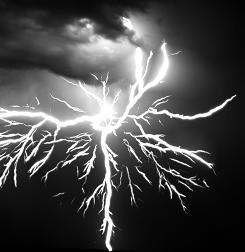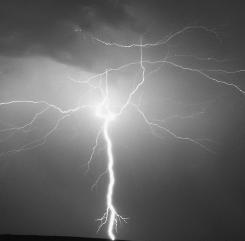The cameras are showing images of lightning that have otherwise been invisible to the naked eye and have never been captured on traditional film or video cameras.
Just as photography first revealed how horses' legs actually function while at a full gallop, so too does this new technology allow us to see how lightning strikes actually work.

"The high-speed video recording systems are providing an entirely new dimension in our understanding of lightning - namely, time, with enough resolution to see entirely new processes in the spatial development of intracloud and cloud-to-ground flashes," says E. Philip Krider, an atmospheric scientist and lightning expert at the University of Arizona, in an e-mail.
Says Tom Warner, a meteorologist with ZT Research in South Dakota, who studies high-speed videos of lightning: "There are components of lightning that we could not see optically before. The beautiful thing about high-speed cameras is that they show us the lightning progression image by image, which is what the human mind is used to seeing, and therefore make it much easier to visualize and understand."
These images are not only invisible to the human eye, but they can't be captured by conventional video cameras, which produce just 30 to 60 images a second. High-speed video cameras can capture several thousand images a second.
Warner says Vlad Mazur, a scientist with the National Severe Storms Laboratory in Norman, Okla., was the first to study storms using a 1,000-image-per-second camera in the early 1990s. Warner adds that it has been only in the past three or four years that technology has enabled him and other scientists to use high-speed video to study lightning, when "the speed and therefore the resolution increased significantly to allow for meaningful resolutions to be captured at speeds above 5,000 images per second."
Lightning is, well, "lightning fast." According to the National Center for Atmospheric Research in Boulder, Colo., a lightning bolt's downward leader (the initial discharge) speeds toward its target at 136,000 mph, while the luminous return stroke into the clouds moves at 62 million mph. These strokes are so fast that the human eye sees just a single flickering lightning bolt.
The high-speed cameras can show the previously unseen structure of the first part of lightning bolts, the forked "stepped leaders" that move toward the ground in a series of jumps and then spark the more visible return stroke. All of this occurs in less than half a second.
The research does have relevance for practical applications. Says Warner, "It's crucial that we make better models based on actual data and observations, such as from high-speed videos, rather than models based on theory." Better models would make for improved lightning protection, he says.
Lightning is one of the USA's deadliest weather phenomena. In a typical year it kills more than 60 people, according to the National Weather Service. Based on a 30-year average of data from 1978 to 2007, that is more people than are killed each year by either tornadoes or hurricanes.
Eventually, Warner hopes to use video cameras that can capture 100,000 images a second.
Scientists say we're only at the beginning of studying lightning with such cameras. In a 2008 paper in Geophysical Research Letters, lead author Marcelo Saba of the National Institute for Space Research in Brazil noted that high-speed video observations will be crucial in building on scientific understanding of cloud-to-ground lightning flashes.




Reader Comments
to our Newsletter